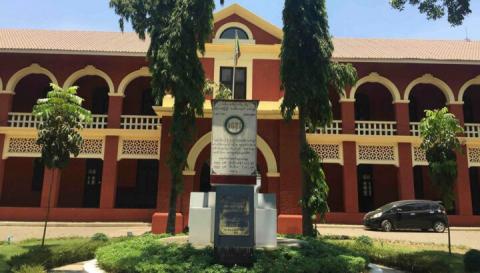Government Technical Institute and the Vocational Education System
The State Counsellor, in her “on-line” message on the occasion of the 125th Anniversary of the Government Technical Institute (GTI) Vocational Education System said that “In building a modern and developed Democratic Federal Union, it is very important for the GTI schools to be of high quality in order to produce highly qualified technical professionals, professionals and technicians”. The State Counsellor has always been a strong supporter of Technical Vocational Education and Training (TVET) whether in public or private sector and the students may well be proud of it. As she has pointed out in her address, TVET Schools and Institutes are needed to meet the countries need for professionals and technicians.
Engineering Technicians, who are being trained by Government Technical Institutes and some private sector schools, are persons who have expertise in the practical application of engineering knowledge in the various fields of engineering such as Mechanical, Electrical, Construction, Mining, and so on. They also supervise “on site”, engineering works and processes. Nowadays it seems the GTI’s scope has been broadened to train “technicians” in other Production fields as well.
Engineering Technician Education
Myanmar’s Engineering Technician Education can be said to have gained a foothold when the Government Technical Institute, Insein was established. There has been 25 GTI and 3 GTC schools established all over Myanmar since then. But the Insein GTI, which has been honoured as a “Cultural Heritage Site” is being developed into a “Hub” for Technical and Vocational Training and Education. The Government Technical Institute (GTI) courses are in the Technical and Vocational Education and Training (TVET) stream of “Post-Secondary Education” in the UNESCO’s classification of Education Systems. The AGTI Diploma holders, through service and experience could, and as many did, rise up to the level of Executive Engineers and Chief Engineers and some even higher, in their organisations. In fact in the highest level of their careers they would be termed Professional Engineers (PE) on par with any engineering higher degree holder. However many new AGTIs would still like to have a “degree”.
The Bachelor of Engineering Degree like other professional degrees awarded by the Universities is under the UNESCO classification of “Tertiary Education”. The BE degree curricula are of six years duration after Matriculation and focusses more on the conceptual aspect of Engineering Technology including “design, calculations, application and maintenance” while the AGTI curriculum is of three years duration after matriculation and focusses more on the practical application and maintenance of engineering processes and facilities.
For the AGTI Diploma holder aspiring to get a “ BE Degree” there are several “pathways”. The present pathway is “bridging” to a BE degree course after passing the “entry” requirements of the BE degree course concerned. The next option would be to join a BE degree course offered on-line as a program of the concerned University. Another would be to link with Open University running Engineering Degree Courses in-country (if any) or abroad. There may still be other “pathways” to acquiring an academic “degree”.
Myanmar Engineering Council Law
However, an alternative for the AGTI Diploma Holders, to advance their “qualification” further could be for them to seek the Myanmar Engineering Council’s registration of practising Engineering Technicians and Engineers in line with the Myanmar Engineering Council Law and Rules. According to the Myanmar Engineering Council Rules, registration system of Technologists and Technicians is from the level of “Registered Technician”(R.Tech) for an engineering diploma holder(like AGTI), “Registered Graduate Technician” (R.G Tech) on to “Registered Engineer” (R.E) for BE Engineering Degree holder and upward to “Registered Senior Engineer” (R.S.E) ending in the award of “Registered Professional Engineer” (PE) the highest registration (recognition) in the engineering profession according to the Myanmar Engineering Council Law.
Registration of engineers from the level (not taking into account “Apprentice Engineers”) of Engineering Diploma Holders involves a required period of engineering service and attendance in a short training course followed by a written exam. Those who are successful in the written exam are required to submit a paper of his/her career followed by an interview by the “Assessment for Registration Working Committee” of the Engineering Council. The registered Engineering Technician after a period of required service can take the Engineering Councils’ Examination to be a Registered Engineer as is stipulated in the Law.
It would perhaps help the assessment process if the candidates could be required to submit, in support of their paper, their “Portfolios” of learning and experience gained as Engineering Technicians/ Technologists. A “Portfolio” could be required especially from Senior Engineers. It would make it easier for the assessors to assess the applicant’s knowledge and competence.
Engineer Registration Scheme
The Engineer Registration scheme of the Engineering Council came into being only after the Myanmar Engineering Council Law was enacted in 2013 followed by the “Rules” in 2014. The Apex body and the Working Committees have been formed and the award of “qualifications” in the form of Registration for recognition at the relevant level is underway. The AGTI Diploma holder could follow the Engineering Council’s Registration upwards step by step up to the level of “Professional Engineer,” which would be equivalent to the highest “Degree” awarded in the academic stream.
With charity to all and malice to none.
Reference:-
1. The Myanmar Engineering Council Law . (2013)
2. The Myanmar Engineering Council Rules . (2014)
By Lokethar
Photo: GTI INSEIN.TVET.EDU
#TheGlobalNewLightofMyanmar

